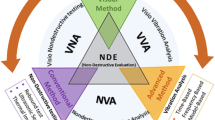Abstract
In-situ monitoring of the condition of materials has the potential for reducing the risk of failures, improving maintenance scheduling and costs, and allowing predictions of component life. Stress-corrosion cracks have been shown to emit acoustic signals, and correlations between crack area and the number of acoustic emission events have been developed in laboratory tests. On-line monitoring will require the ability to discriminate between background and crack growth signals. Acoustic emission characteristics such as event rate, amplitude and rise time can be used to discriminate between valid and invalid events. A summary of acoustic emission from stress-corrosion cracking initiation and long crack growth, acoustic emission characteristics, and potential applications is given in this article.
Similar content being viewed by others
References
H.N.G. Wadley, C.B. Scruby and J.H. Speake, Intl. Metals Reviews, Review 249 (1980), p. 41.
E.N. Pugh, Proceedings of Atomistics of Fracture, ed. R.M. Latanision and J.R. Pickens (New York: Plenum Press, 1983), p. 997.
R.C. Newman and K. Sieradzki, Chemistry and Physics of Fracture, ed. R.M. Latanision and R.H. Jones (The Netherlands: Martinus Nijhoff Publishers, 1987), p. 597.
R.H. Jones, P.H. Hutton, M.A. Friesel and S.M. Wolf, eds., Observations and Identification of Crack Growth Modes in Reactor Steels Using Acoustic Emission, proceedings of a workshop held March 14-15,1984, University of Denver, Denver, Colorado (1984).
P.H. Hutton, K.E. Stahlkopf and E.L. Zebroski, “Detection of Stress Corrosion in Stainless Steel Piping by Acoustic Emission,” Third Conference on Periodic Inspection of Pressurized Components, London, England (1984).
H. Kusanagi et al., The Fifth International Acoustic Emission Symposium, (Tokyo:, 1980), p. 125.
S. Yuyama, T. Kishi and Y. Hisamatsu, J. Matls. Energy Systems, vol. 5 (1984), p. 212.
S. Yuyama, Y. Hisamatsu, T. Kishi and N. Nakasa, Fifth International Acoustic Emission Symposium (Tokyo:, 1980), p. 115.
WJ. Pollock, D. Hardie and N.J.H. Holroyd, Br. Corrosion J., 17 (1982), p. 203.
D.G. Chakrapani and E.N. Pugh, Metall.Trans.A, 17(1982), p. 103.
H.H. Chaskelis, W.H. Cullen and J.M. Krafft, “Fracture Toughness and Slow-Stable Cracking,” STP 559 (Philadelphia, PA: ASTM, 1984), p. 31.
P. Mclntyre and G. Green, Br. J. Non-Destr. Test., 20(3) (1978), p. 135.
A. Nozue and T. Kishi, J. Acoustic Emission, 1 (1982), p. 1.
R. Padmanabhan, N. Suriyayothin and W.E. Wood, Metall. Trans. A, 14A (1983), p. 2357.
V.N. Kudryavtsev, Kh.G. Schmitt-Thomas, W. Stenzel and R. Waterschek, Corrosion, 37 (1981), p. 691.
J. Stewart, P.M. Scott and D.E. Williams, Corrosion 1988, paper no. 285, (Houston, TX: NACE, 1988).
Author information
Authors and Affiliations
Rights and permissions
About this article
Cite this article
Jones, R.H., Friesel, M.A. Using acoustic emission to monitor stress-corrosion cracking. JOM 42, 12–15 (1990). https://doi.org/10.1007/BF03220460
Issue Date:
DOI: https://doi.org/10.1007/BF03220460




